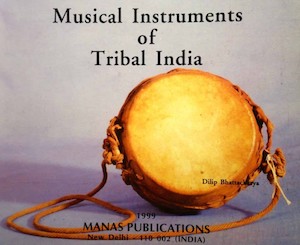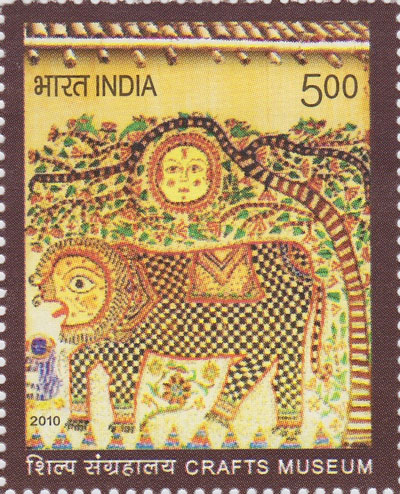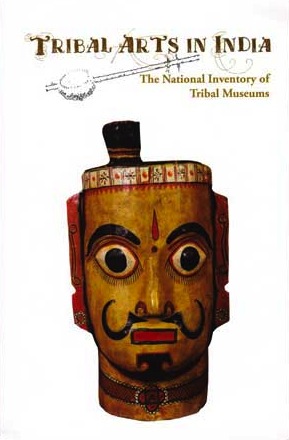Niranjan Mahawar, 75, is a self-taught ethnologist of Chhattisgarh. He spent almost five decades in southern Chhattisgarh to study the life and art of the Bastar tribes. […]
Today, Mahawar — who was made famous in a series of interviews by the writer Dom Moraes — is considered an authoritative voice on central Indian folk art, folklore, tribal myths and theatre. He spoke to Suvojit Bagchi extensively on his work. Excerpts.
[…] what exactly do you mean by Bastar art? The bell metal artefacts…wrought iron ones…the wood carvings?
Well, everything. But first let me say, I won’t call it bell metal but bronze.
Why is it called bell metal?
Bells of temples were made of the metal which is pure bronze. And as you said, besides bronze artefacts, there are wooden carvings, wrought iron, masks, combs… I have about 200 combs. They are all Bastar art. They all tell a story.
Like…
Like this woman Tallur Muttai (shows a picture of a woman in bronze, embracing a child with her left hand and holding a stick with a funnel on top with her right). She, in tribal myth, lives in palmyra fruit trees. To the tribals, palmyra juice is the breast milk of Tallur Muttai. She, therefore, is the earth mother. But then there is the massive Hindu-isation of the tribal myth and the earth mother is made to sit on a tiger as Hindus prefer their goddesses on the tiger. I have a problem with this makeover. If the tribal gods are comfortable on the trees, let them be…why make them a Hindu? Besides, the market forces are also changing the artefacts.
So, in spite of the overlapping of the images of the icons, a tribal is in no way a Hindu?
P.N. Haksar, while heading a national committee on the tribals, once asked that. I said, tribals don’t believe in chatur-varna or the caste system that is the basis of Hindu society. Tribals lived with their native tradition and for over five thousand years refused to get dominated by Hindus. Hence they are not Hindus.
So, the difference with Hindus has been there for a long time?
Of course. In the Ramayana, you have the demon. Remember the woman, Tadoka, the demoness. The word Tar or palmyra is in her name too. I assume, she is the same Tallur Muthai and she, like other rakshas, got a snub-nose. The Gonds have a snub-nose. So while Ram represents the upper caste Hindus, the Aryans, Tadoka and her friends represent the tribal society, the Dravidians. This resistance against the outsiders was documented in modern times by the British gazetteers, anthropologists. They published how the locals resisted them. When the British tried to enter the region, one of the kings of the area, the Raja of Kanker, asked them to refrain. The kings, however, were small and while they also were outsiders, always avoided confrontation with the Bastar tribals.
You mean, Bastar almost always accepted the local rulers, but not the big imperialist forces?
Yes. They will not accept you easily. Even now, you would find tribals while talking among themselves would call you a ‘thug’ — a cheat. They don’t trust outsiders. Now, associate this thought with today’s mining. Bastar will resist mining and outsiders.
You mean the State and its mining policies will not be able to penetrate Bastar?
I cannot say that for sure. The Indian state is far more complex and powerful now.
Maybe this has helped the Maoists…
Of course. Maoists used this sentiment to their advantage. But I think they are extortionists and not Communists.
Source: Interview: “I have a problem with the makeover of tribal culture” by The Hindu, October 24, 2012
URL: http://www.thehindu.com/opinion/interview/i-have-a-problem-with-the-makeover-of-tribal-culture/article4026265.ece#.UIe8jlmo_qw.email
Date Visited: Wed Oct 24 2012 13:24:40 GMT+0200 (CEST)
[Niranjan] Mahawar says that in the strict sense it is a misnomer to use the expression ‘tribal art’ for such objects since tribals themselves view them as utilitarian items rather than works of art. Objects are divided into four primary classes: totems, deities, toys and ornaments and utensils. Toys are used as offerings for the deities and utensils too are used for rituals. The material used is either bellmetal, brass, terracotta, wood or stone. […]
Foreign orders ruined whatever individuality remained, and the artist today has been reduced to a human machine. Says Mahawar disgustedly: “Today the artist produces the same kind of piece of exact specifications over and over again. It has killed his freedom, and what is worse, he earns only the bare minimum. All this is being done in the name of promoting tribal art.” […]
Source: “Tribal art was dying out, commerce reduced good artists to artisans” by Sreekant Khandekar, India Today, 22 August 2014
URL: https://www.indiatoday.in/magazine/society-the-arts/story/19820731-tribal-art-was-dying-out-commerce-reduced-good-artists-to-artisans-772004-2013-10-15
Date Visited: 27 February 2022

Musical Instruments of Tribal India
by Dilip Bhattacharya >>
Chhattisgarh is rich in its cultural heritage. The State has a very unique and vibrant culture. There are over 35 big and small colourful tribes spread over the region. Their rhythmic folk music, dances and dramas are a treat to watch and also provide an insight into the culture of the State.
Generally, tribal life style is described in ‘Dhohas’, which is accompanied by dance. Reflections of tribal philosophy and their ideal music and songs, they mesmerize the viewer into another world. It has a variety of music. The prime musical instruments in cultural performances are ‘Mandaar’, ‘Dhol’ and Drum. Raut Nacha is a popular form of entertainment and accomplished drama for seven days of the festival of Deepawali. It portrays the diverse stories of war during Mahabharata times as dance and music in an unusual way. In addition, verses of poet Kabir and Tulsi fill the memory of ancient times in the mind of the prehistoric tribal communities of Chhattisgarh.
Source: Culture & Heritage | District DURG, Government of Chhattisgarh
URL: https://durg.gov.in/culture-heritage/
Date Visited: 27 February 2022
[Bold typeface added above for emphasis]

wildlife tourism and conservation policies >>
When your neighbour is a tiger | People’s Archive of Rural India
People living near or within the forest in the Bandipur National Park and the Sundarbans revere as well as fear the tiger. Their proximity to tigers, leopards, crocodiles and other big animals often causes violent confrontations, but it has also inspired myths and conservation. Here are PARI’s tales from tiger territory >>
“What I wanted to do was to make people, for whom Indian democracy and institutions mean something, think about the places where it fails so utterly and completely, and how their own lives are connected to these other citizens.” – Nandini Sundar (Professor of Sociology, Delhi University), interviewed by Chitrangada Choudhury (Livemint, 10 October 2016)

Tribal Arts in India | Worldcat.org >>
Free eBooks & Magazine by Bhasha Research and Publication Centre: Adivasi literature and languages >>
See also